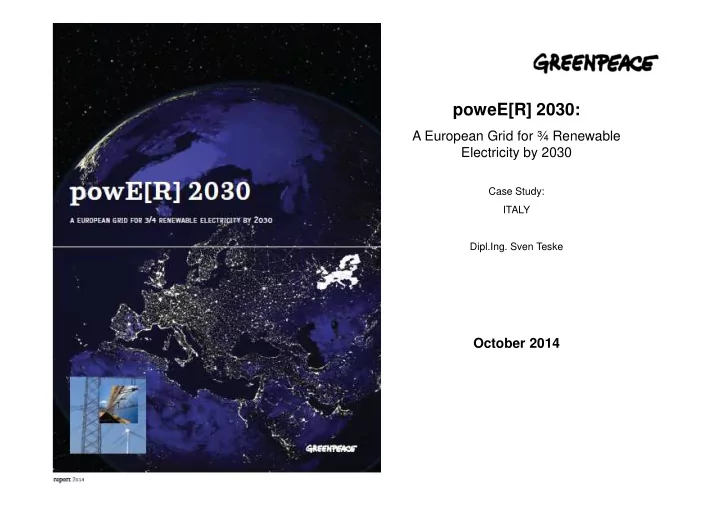

poweE[R] 2030: A European Grid for ¾ Renewable Electricity by 2030 Case Study: ITALY Dipl.Ing. Sven Teske October 2014
Background of the powE[R] 2030 study: 1. Report builds on two earlier analysis from 2009 and 2011 “[r]enewables 24/7” consulting company ENERGYNAUTICS and GREENPEACE INTERNATIONAL developed a European Grid Model 2. Grid Analysis “powE[R] 2030 compares 3 different cases to study: - requirements for grid integration of renewable power - requirements for grid expansion for 75% RE power by 2030 3. Challenge the current ENTSO-E Ten Year Development Plan (TYNDP)
Simulation of 3 cases: 1. The Reference Case is based on the ‘business as usual’ scenario of: - IEA Current Policies scenarios (WEO 2011) - power plant capacities for 2020 + 2030 are equal to ENTSO-E TYNDP 2. The Greenpeace Energy [R]evolution Case for Europe (published December 2012) - 75% renewable electricity by 2030 - broken down to 30 countries (28 EU member states +Norway, Switzerland) 3. The Conflict Case - France, Czech Republic and Poland keep inflexible coal/lignite/nuclear power - E[R] case for all other European countries
Methodology: Installed capacity by case for Europe (EU 28 + 2) RE electricty share: 37% 59% 77%
Methodology: Renewable Electricity Share by Country:
Methodology: The network model: • 200+ nodes representing major load and generation sites in ENTSO-E area • 400+ AC lines for major transmission corridors with capacities [in MVA] and impedances • All existing HVDC lines with capacities [in MW] • ENTSO-E’s Ten Year Network Development Plan (TYNDP) from 2012 split into mid- and long-term projects • Network model built in DIgSILENT PowerFactory
Methodology: Inputs: • Initial network topology - for High Voltage Alternating Current (HVAC) - and High Voltage Direct Current (HVDC) - with line capacities [MW] aggregated EU grid model • Installed capacities - for all power plant technologies in Giga-Watt [GW] - yearly electrical load in Terawatt hours per year [TWh/a] for all European countries according to Greenpeace and/or IEA scenarios • Energynautics’ distribution key for how the technologies are distributed in each country - Wind and PV according to potential, - conventional generation sources according to existing capacity • Time series for the weather year of 2011 to calculate the feed-in - for variable renewables, including wind and solar insolation; - the load profile for 2011 per country taken from ENTSO-E published profiles
Methodology: Outputs: • The necessary network extensions and costs • Dispatch per node of technologies, including: - curtailment for variable renewables - load factors for controllable generators • Network flows for AC and DC lines
Methodology: Costs taken from ENTSO-E
Methodology: Technologies Assumptions
Methodology: Assumption for inflexible generation (coal and nuclear)
Methodology: Assumption for flexible generation e.g solar photovoltaics
Example: Cross Border System Conflict in the Grid - France versus Germany in the Summer • Inflexible controllables running flat out at 90% of nominal power the whole year - flexibility band 20%
Results: Capacity factor of conventional generation in selected countries in three scenarios
Results: Load coverage + load factors factor by technology/Imports in 2030 under the energy [r]evolution
Main Expansion: • AC inter-connection between countries • DC over-lay − East-West − North-South
Load Coverage of the energy [r]evolution by country for 2030
Curtailment rates of wind + solar by country and scenario for 2030
Key Results + Comparison with ENTSO-E
Energy [R]evolution: Two times more RE with half the transmission and line expansion
Italy becomes an export country for Renewable Dispatch Services in 2020 Dispached Energy per year Italy [MWh/a] REF 2020 Dispatched Energy per Year in MWh/a imports renewable non-renewable Italy 36.611.862 121.510.827 153.211.486 REF 2030 Dispatched Energy per Year in MWh/a imports renewable non-renewable Italy 33.283.120 143.567.911 158.755.065 Conflict 2020 Dispatched Energy per Year in MWh/a imports renewable non-renewable Italy 32.282.596 124.103.516 123.440.023 Conflict 2030 Dispatched Energy per Year in MWh/a imports renewable non-renewable Italy 27.136.458 164.797.927 116.448.872 ER 2020 Dispatched Energy per Year in MWh/a imports renewable non-renewable Italy -6.725.169 133.830.108 152.721.195 ER 2030 Dispatched Energy per Year in MWh/a imports renewable non-renewable 38.986.801 176.578.282 92.818.175
1 billion Euro less fuel costs by 2030 Fuel Costs per country REF 2020 Fuel Costs in Euro/a coal lignite gas total Italy Italy 524.604.794 0 1.382.944.051 1.907.548.844 REF 2030 Fuel Costs in Euro/a coal lignite gas total Italy Italy 515.150.029 0 1.526.105.858 2.041.255.887 Conflict 2020 Fuel Costs in Euro/a coal lignite gas total Italy Italy 368.555.911 0 1.257.619.804 1.626.175.715 Conflict 2030 Fuel Costs in Euro/a coal lignite gas total Italy Italy 484.808.697 0 831.049.564 1.315.858.261 ER 2020 Fuel Costs in Euro/a coal lignite gas total Italy Italy 16.904 0 2.796.350.026 2.796.366.931 ER 2030 Fuel Costs in Euro/a coal lignite gas total Italy Italy 37.065 0 1.730.065.959 1.730.103.024
Thank you very much! sven.teske@greenpeace.org
Recommend
More recommend